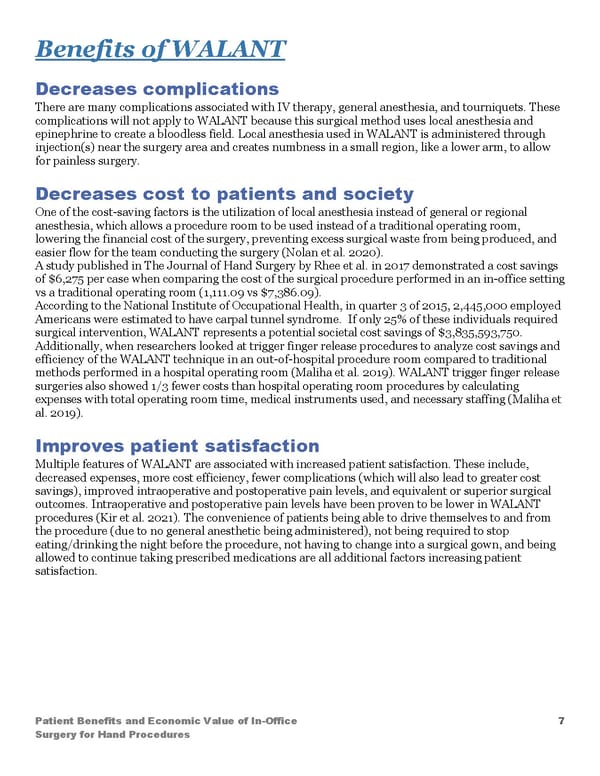Benefits of WALANT Decreases complications There are many complications associated with IV therapy, general anesthesia, and tourniquets. These complications will not apply to WALANT because this surgical method uses local anesthesia and epinephrine to create a bloodless field. Local anesthesia used in WALANT is administered through injection(s) near the surgery area and creates numbness in a small region, like a lower arm, to allow for painless surgery. Decreases cost to patients and society One of the cost-saving factors is the utilization of local anesthesia instead of general or regional anesthesia, which allows a procedure room to be used instead of a traditional operating room, lowering the financial cost of the surgery, preventing excess surgical waste from being produced, and easier flow for the team conducting the surgery (Nolan et al. 2020). A study published in The Journal of Hand Surgery by Rhee et al. in 2017 demonstrated a cost savings of $6,275 per case when comparing the cost of the surgical procedure performed in an in-office setting vs a traditional operating room (1,111.09 vs $7,386.09). According to the National Institute of Occupational Health, in quarter 3 of 2015, 2,445,000 employed Americans were estimated to have carpal tunnel syndrome. If only 25% of these individuals required surgical intervention, WALANT represents a potential societal cost savings of $3,835,593,750. Additionally, when researchers looked at trigger finger release procedures to analyze cost savings and efficiency of the WALANT technique in an out-of-hospital procedure room compared to traditional methods performed in a hospital operating room (Maliha et al. 2019). WALANT trigger finger release surgeries also showed 1/3 fewer costs than hospital operating room procedures by calculating expenses with total operating room time, medical instruments used, and necessary staffing (Maliha et al. 2019). Improves patient satisfaction Multiple features of WALANT are associated with increased patient satisfaction. These include, decreased expenses, more cost efficiency, fewer complications (which will also lead to greater cost savings), improved intraoperative and postoperative pain levels, and equivalent or superior surgical outcomes. Intraoperative and postoperative pain levels have been proven to be lower in WALANT procedures (Kir et al. 2021). The convenience of patients being able to drive themselves to and from the procedure (due to no general anesthetic being administered), not being required to stop eating/drinking the night before the procedure, not having to change into a surgical gown, and being allowed to continue taking prescribed medications are all additional factors increasing patient satisfaction. Patient Benefits and Economic Value of In-Office 7 Surgery for Hand Procedures
 Patient Benefits and Economic Value of InOffice Surgery for Hand Procedures Page 6 Page 8
Patient Benefits and Economic Value of InOffice Surgery for Hand Procedures Page 6 Page 8